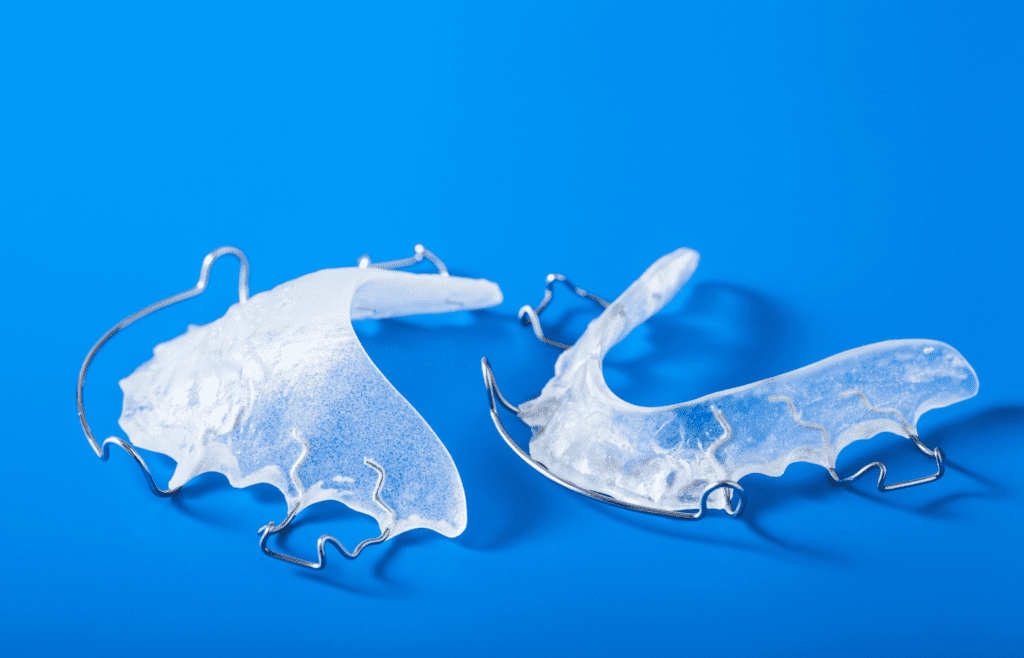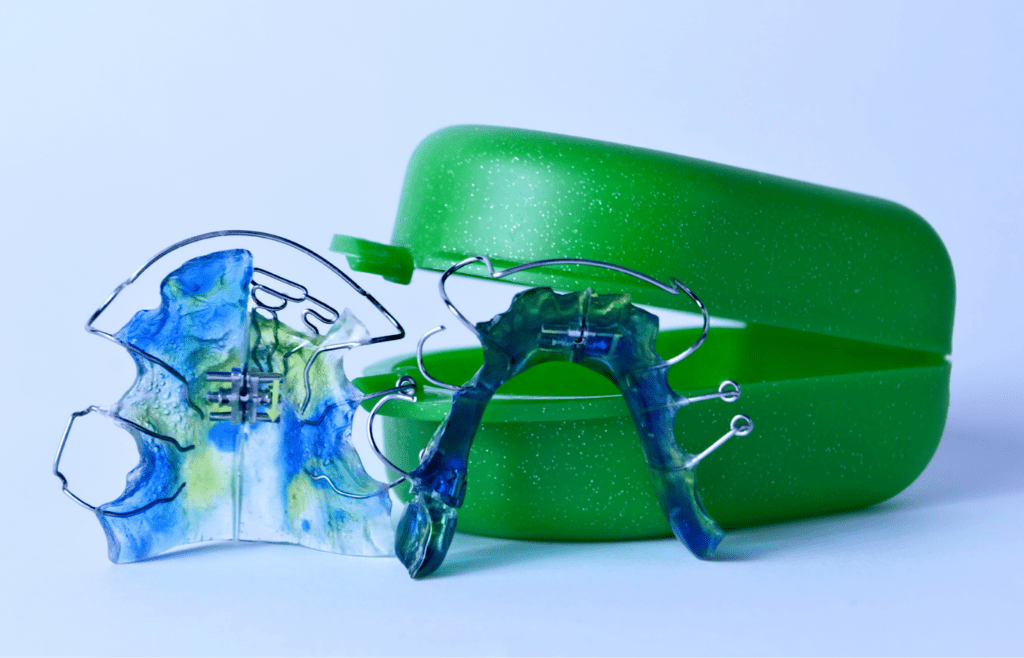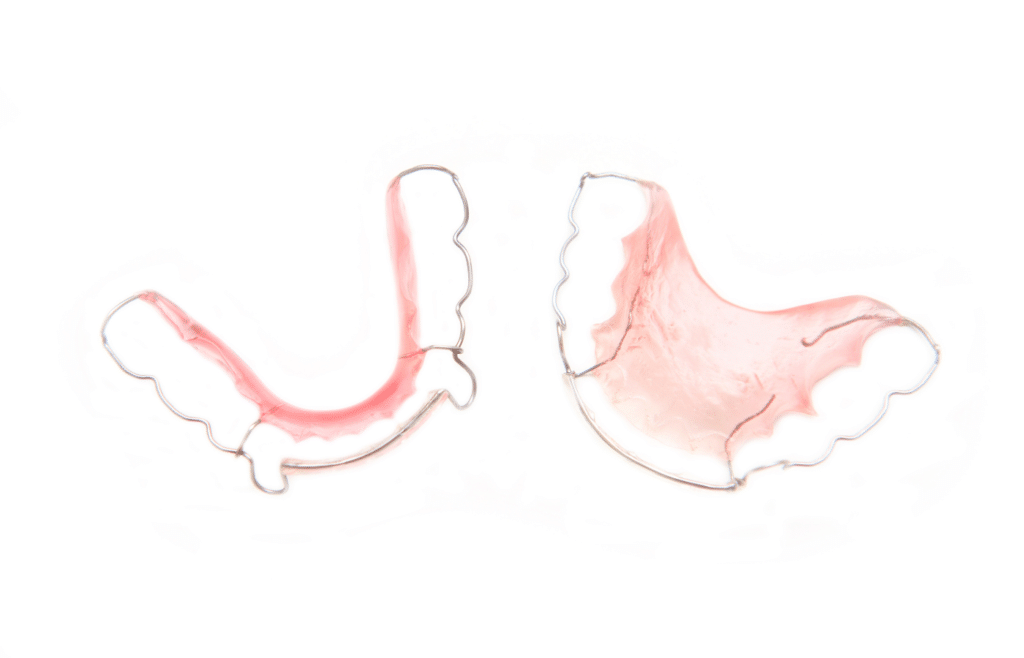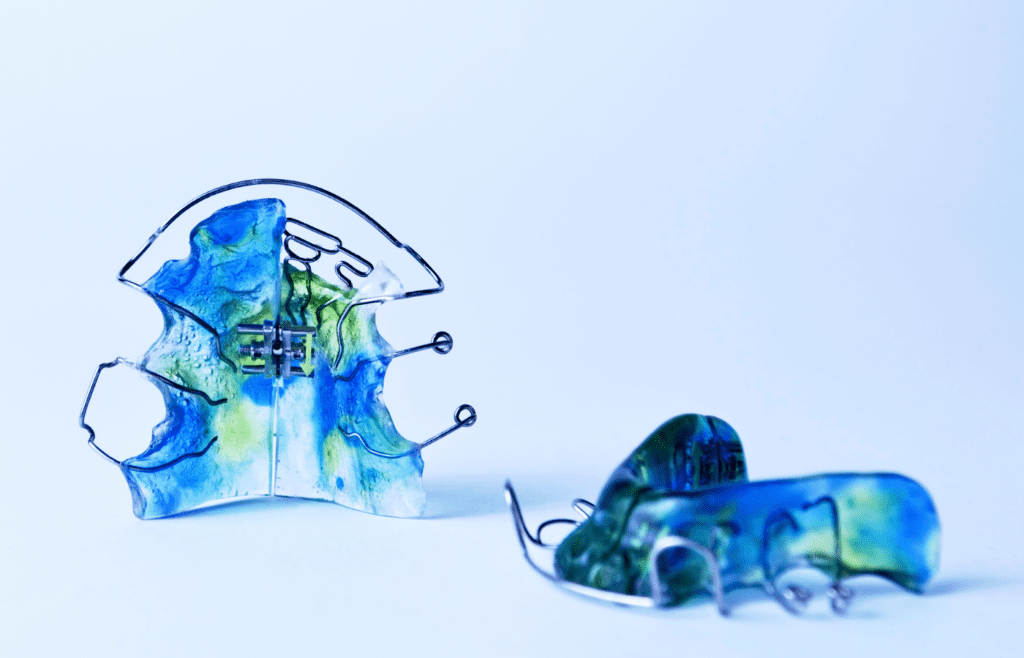
With a ten-year-old son and eight-year-old daughter, we recently entered the exciting (and expensive!) world of orthodontic treatment.
My main thought is: Why didn’t anyone tell me to start saving for this when the kids were newborns?
The investment in dental appliances and oral health is no small thing. And the equipment they provide doesn’t come cheap. So caring for your retainer is of the utmost importance.
If you’ve arrived at this article, your child is likely wearing a clear or plastic retainer. Often, a new retainer is used after the braces come out to hold everything into place. Even after the teeth have been corrected by braces, they can shift over time, so a retainer helps prevent this from happening.
(Boy, I never thought I’d be writing an article about orthodontics, but here we are.)
Clear plastic retainers slip over your teeth and are basically invisible, so many kids like them for that reason.
However, as you can probably imagine, daily use means that retainers can be a breeding ground for all kinds of bacteria, plaque, and tartar as it sits against your child’s teeth all day and sometimes even at night.
Quick Overview:
- Brush your retainer with soap and water when you brush your teeth at night.
- Use a different toothbrush from the one you use on your teeth.
- If it’s not in your face, it should be in the case.
Do You Need To Clean Plastic Retainers?
It’s extremely important to take proper care of your retainer. First of all, if you don’t keep it clean, it may start to smell or taste badly. Gross!
Even more importantly, a dirty retainer could harbor dangerous bacteria (i.e. Streptococcus, S. sanguinis, S. mitis, and S. salivarius, Lactobacillus, Veillonella, and Candida albicans). People with compromised immune systems need to be especially careful to prevent bacteria growth on their retainer. It’s important to let your doctor know right away if you experience any irregular symptoms like redness or swelling in your mouth.
Finally, no matter what type of retainer you have, proper retainer care ensures that it will last a long time.
For this reason, It’s helpful to think of removable retainers as an extension of your teeth. It follows that orthodontic retainers need to be cared for and cleaned every single day, similar to your current oral hygiene routine.

A simple solution is to implement a daily cleaning routine for your retainer when you brush your teeth at night. Adding a step on to something you already do every night (like brushing your teeth), is the best way to make sure you stick with this new habit.
Here are some tell-tale signs that you really need to clean your retainer:
- Your retainer smells bad
- Your retainer tastes bad
- There is a film on the retainer
- Your retainer looks cloudy
- There are white spots on the retainer. White spots could be a sign of mineral buildup, or tartar, plaque that can cause cavities, or some combination of the two.
- Breaking or cracking. (Bacteria can also cause physical damage to the retainer over time.)
- Increased dental problems like getting cavities, experiencing tooth sensitivity, and tooth decay can indicate that there might be a problem with the retainer, the oral hygiene routine, or the way the retainer fits.
How to Clean Clear Retainers
Fortunately, cleaning retainers is fairly straightforward once you’ve gotten into the habit of doing it. Here are some tips for the most effective way to clean your little contraption:
Tip #1: Clean your retainer daily with a soft bristle toothbrush.
First, it’s best to use a different toothbrush than the one you use for your teeth.
Each night after you brush your teeth, mix lukewarm water (not hot water) with mild soap (castile soap or mild dish soap both work well). Don’t use toothpaste because regular toothpaste is abrasive and can actually scratch the retainer’s surface.
Dip a soft toothbrush or denture brush into the soap and water mixture and gently brush the surface of your retainer to scrub away the food particles, plaque and debris.
For best results, give it a thorough cleaning using a cotton swab to clean out the deeper grooves and ridges.
Finally, rinse the retainer with cool water or cold water.
Manually removing the soft plaque in this way is the best way to ensure that the plaque does not harden into tartar. This is the single most important way to care for your retainer and make sure it lasts a long time.

Tip #2: Clean your retainer right when you remove it from your mouth.
Your retainer should still be wet when you clean it. That’s how fast you should move. The reason why this is a good idea is because the moisture will help make it easier to clean off any debris, before the debris hardens. (Yuck!)
Tip #3: Keep a container of cotton swabs on your bathroom counter.
Keeping cotton swabs visible and accessible on your bathroom counter will make it more likely that you will actually use them to do a deep cleaning of debris, plaque, and tartar on your retainer. You can use these to easily get into the deeper grooves and ridges of your retainer.
Tip #4: Keep your retainer in a case.
Remember every orthodontist’s favorite rhyme: if it’s not in your face, it’s in the case.
A retainer case is vital to keeping your retainer safe and intact. It prevents the retainer from being crushed, thrown away accidentally, chewed up by your family pet, or choked on by your younger sibling. It also keeps it clean from outside-of-the-mouth dirt and debris.
Watch your pets & younger siblings! It’s important to keep your retainer in a safe place up high and out of reach, especially if you have pets or younger siblings who may try to put it in their mouths. They could choke on it.
Put your retainer in your case while you’re eating. Many people have put their retainer on a napkin or plate while they’re eating, and then it accidentally gets thrown away.
Also, don’t forget to clean your case! Your retainer case can get really nasty, really fast. Clean it once a day before you put your retainer away. You can simply scrub all surfaces in warm, soapy water, then rinse it off and pat it dry.

Tip #5: Deep clean your retainer once a week.
A deeper weekly clean is a great way to keep your retainer looking very new, and it will help kill harmful bacteria that cause bad breath and illness. Plus, it breaks up plaque and tartar that you may have missed during the week with your daily cleanings.
It’s best to use gentle and natural ingredients for soaking your retainer.
For example, you can soak the retainer for 5-10 minutes in your own solution of equal parts white vinegar and water, then scrub gently with a toothbrush. White vinegar is a safe and gentle disinfectant that is especially effective in removing odors. This is a good option for people who want to use a soak with natural ingredients.
You can also use a mixture of equal amounts of water and hydrogen peroxide.
Or, a 50/50 water and baking soda mixture is an effective way to deep clean your retainer, as well. Baking soda in particular is a tried-and-true natural disinfectant that is safe to use. It is very useful for whitening retainers that may have yellowed.
An alternative method is to use retainer cleaners that consist of an effervescent tablet (i.e. Retainer Brite) and then scrub gently with a toothbrush and rinse. It works the same way as a denture cleaner, but without the harsh chemicals and harmful cleaning agents that can damage your retainer.
It’s not a good idea to use denture tablets or a mouthwash soak because the harsh chemicals can be harmful to your retainer’s longevity.
Regular soaking each week will help your retainer stay in tip-top shape and last a long time.

Other things to keep in mind:
Difficult Spots: If there is a stubborn piece of debris, hardened tartar, or mineral deposits that you can’t seem to get rid of, you should let your orthodontist know. They may be able to use a more advanced method to remove it.
Water: Water can’t clean the retainer on its own, but it’s better than nothing when you’re on the go because it can help prevent bacteria overgrowth. Especially if you drink a soda or sugar drink, and after eating snacks throughout the day, swishing some water in your mouth a few times can go a long way.
Avoid Heat: Avoid exposing your retainer to high heat. That includes boiling water, microwaves, dishwashers, washers and dryers, and even the dashboard of your car.
Replacement: Different types of retainers last for varying amounts of time. But how well you take care of your retainer will determine how long it lasts. For example, Hawley retainers tend to last longer than clear retainers as a general rule. If your retainer is very worn out or no longer fits properly, it’s time to get a new one.
Summary:
If you take nothing else away from this article, simply brush your retainer at the same time that you brush your teeth at night.
And, if it’s not in your face, it should be in the case!
Finally, if you want to be pro-active or notice buildup on your retainer, give it a deep soak weekly.
At the end of your long orthodontic journey is an even more beautiful smile than the one you already have!
Related Posts:
Tooth Pulling 101: Your Guide to Pulling a Loose Tooth
Calie Herbst, Editor-in-Chief of Milwaukee With Kids, has spent over a decade combining her experiences as a parent of three to create a hub for Milwaukee’s family adventures.
Her decade-long teaching career in Milwaukee Public Schools and academic background, including a Master’s in Teaching from Marquette University and dual B.A.s in Sociology and Spanish from the University of Wisconsin – Madison, fuel her passion for inclusive and engaging family content.
Calie is also a recognized voice in local media, contributing to WISN Channel 12 News, WTMJ Wisconsin Morning News, Fox 6’s Real Milwaukee, and B93.3.
Discover more about Calie’s journey and editorial approach on her About Page and Editorial Policy Page.









